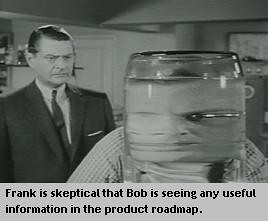The end of roadmap secrecy?
A long time ago, in a much different job in a galaxy far, far, away, we used to joke that there were three product roadmaps: (1) the customer-facing one, which was laconic to the point of uselessness; (2) the official roadmap for the product team; and (3) the architect’s super-double-secret roadmap.

On the other end of the continuum, you have companies like Salesforce, which is willing to make its roadmap visible, to a very substantial extent, to anyone browsing the corporate web site. Salesforce won’t tell you everything they’re doing, like potential acquisitions or partnerships. However, the IdeaExchange drives product enhancements in a very transparent way.
Most technology companies aren’t willing to make their roadmaps as visible as Salesforce’s, but the percentage that are increases daily. Open source may have given a cultural boost: anyone with strong enough motivation could add new functionality to the project. However, the open source community won’t convince a CEO that it’s a good idea to make a commercial product’s direction visible to everyone–including competitors.
I can’t think of any product, including security tools, that have a good reason to hide every part of their roadmap. Both customer and vendor benefit from openness. For some executives, however, it may feel like they’re walking around naked for a little while.